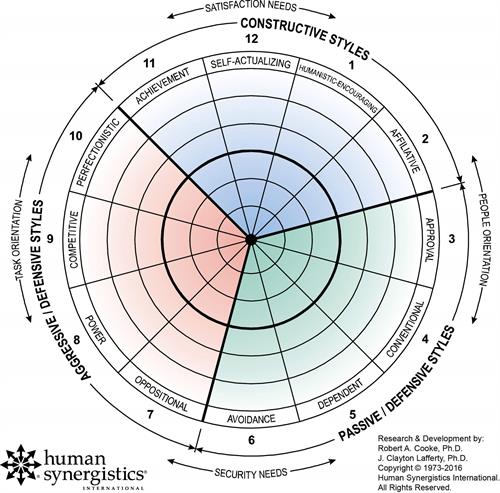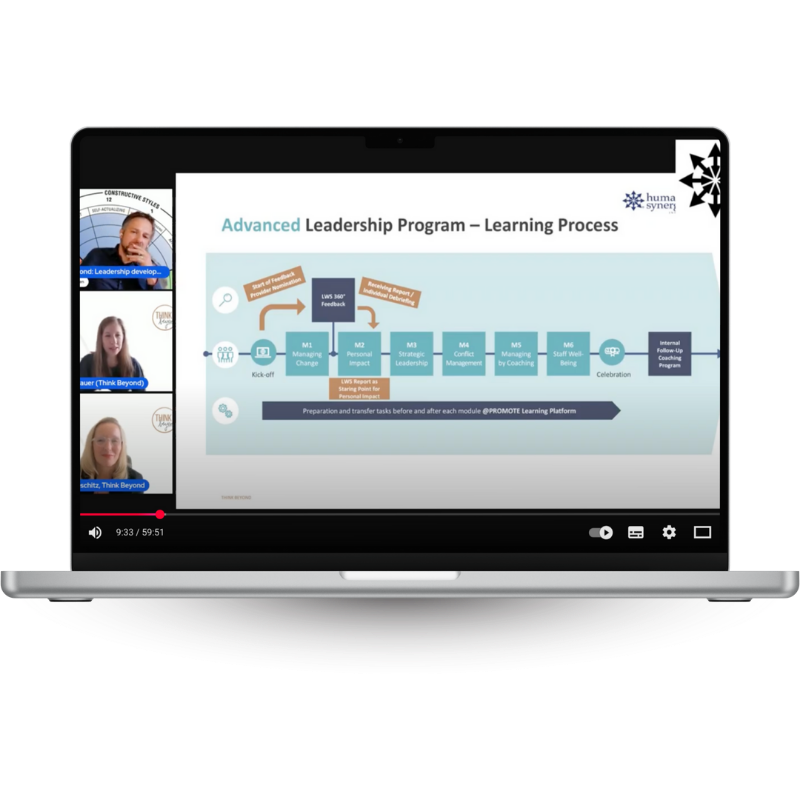How can we elevate global programs with the 360°-feedback tool LWS? This is part 2 of the 4-part series on this topic, where we use a real-life case study to discuss success factors for global programs and dive deep into transfer design and behavioral change. If you missed part 1, you may want to read it first. And now, let’s dive right in!
Table of contents
Here's a conversation we often have with L&D managers: "We're considering different 360° feedback tools for our leadership program. What makes LWS effective?" It's a great question, because the tool you choose shapes the developmental experience your leaders have and the outcomes you achieve. Today, we're exploring what makes LWS distinctively effective—its science-based framework, its approach to feedback, and how one organization is using it to create breakthrough moments that transform individual leaders and organizational culture. But first: What is LWS?
1. What is LWS?
LWS (Leadership/Work Styles) is a framework-based 360° feedback tool designed specifically for leadership development. Key benefits for organizations:
- Science-based roadmap: The Circumplex model (view below) maps constructive vs. defensive behaviors, giving leaders clear development paths—not just random data points
- Global consistency: Validated across 20+ languages, enabling consistent leadership development in multinational organizations
- Accessible insights: Text-based narrative feedback leaders can understand without extensive coaching
- Psychological safety: Explicitly developmental (not evaluative) design encourages honest self-reflection
- Measurable ROI: Re-measurement capability proves behavior change, demonstrating that leadership investments create lasting impact
1. The Challenge: When Feedback Feels Like Random Opinions
Typically, leaders receive a 360°report full of ratings: Strategic Thinking 3.4/5.0, Delegation 2.9/5.0, Communication 3.8/5.0. The leader thinks: “Okay, my delegation score is lower. But what does that mean? What am I actually doing? And what should I do differently?” Without a framework to make sense of the feedback, it hast not much more individual value than random opinions. This is where LWS comes in.
2. The LWS Difference: Science-Based Feedback with a Roadmap
LWS takes a fundamentally different approach. It’s built on a scientifically validated framework that doesn’t just measure leadership behaviors — it explains how those behaviors connect, what consequences they create, and what constructive alternatives exist. Let’s break down what makes LWS unique and why each distinction matters for leadership development.
The Foundation: The Circumplex Model
At the heart of LWS is the Circumplex—a research-based model developed over decades that maps leadership behaviors into three distinct clusters:
Constructive Styles (the blue zone on the Circumplex): These are behaviors associated with high performance, satisfaction, and sustainable results:
- Achievement: Setting challenging but realistic goals, pursuing excellence, striving to do things better
- Self-Actualizing: Thinking creatively, enjoying work, developing yourself, and finding fulfillment
- Humanistic-Encouraging: Supporting others’ growth, being helpful and supportive, coaching and developing people
- Affiliative: Building cooperative relationships, dealing with others in a friendly way, working well in teams
Passive-Defensive Styles (the green zone): These are behaviors driven by beliefs that you need to protect yourself by going along with others and avoiding confrontation:
- Approval: Seeking approval from others, going along to get along, avoiding conflict
- Conventional: Following rules and procedures, making favorable impressions, fitting in
- Dependent: Doing what’s expected, pleasing those in authority, relying on others for decisions
- Avoidance: Shifting responsibility to others, avoiding accountability, staying in your comfort zone
Aggressive-Defensive Styles (the red zone): These are behaviors driven by beliefs that you need to protect yourself through power and control:
- Oppositional: Being critical and challenging, pointing out flaws, being hard to impress
- Power: Controlling others and situations, maintaining authority, wanting to be in charge
- Competitive: Winning at others’ expense, comparing yourself to others, being better than peers
- Perfectionistic: Setting unrealistically high standards, focusing on details, avoiding mistakes at all costs
Here’s why this framework creates so much more value than just data: It shows leaders not just what they’re doing, but why those patterns exist and what the alternatives are.

The Circumplex – by Human Synergistics
Why the Circumplex Creates Breakthrough Moments
When a leader sees high oppositional and competitive behaviors (aggressive-defensive) and low humanistic-encouraging behaviors (constructive), very often something happens inside them. They start to see a pattern. And they understand these behaviors form a coherent system. One leader shared:
“I had no idea I was perceived as micromanaging. When I saw my perfectionistic scores and understood how that pattern connects to controlling behavior, it clicked. I wasn’t helping my team develop—I was preventing them from growing.”
That’s the power of a framework. It turns “you got a 2.9 on delegation” into “here’s the behavioral pattern you’re running, here’s why, and here’s what constructive alternatives look like.”
From Data to Narrative: The Text-Based Advantage
LWS provides text-based, narrative feedback rather than just numerical data. Instead of “Conflict Management: 3.2/5.0,” a leader reads: “Your feedback suggests you tend to avoid addressing conflicts directly, hoping they’ll resolve themselves. While this reduces short-term tension, it often allows small issues to grow. Your team may feel frustrated that concerns don’t get addressed, leading them to stop bringing issues forward.”
The difference? The first requires interpretation. The second provides insight, explanation, and direction.
Global Validation: Why This Matters for International Organizations
For multinational companies, here’s the challenge: How do you develop leaders consistently across cultures when “good leadership” varies by region? LWS is validated across cultures and available in over 20 languages—not just translated, but validated with culturally appropriate norms. This means:
- Consistency: A common framework across your organization
- Cultural sensitivity: Norms that account for how behaviors are expressed differently
- Meaningful comparison: True behavioral differences versus cultural variations
For global L&D, you can run consistent development programs worldwide without imposing a single cultural perspective.
Development Focus vs. Assessment Focus: The Psychological Safety Factor
Perhaps the most important distinction: LWS is explicitly designed for development, not evaluation. Many 360° tools feel evaluative—essentially performance reviews from multiple perspectives. This might trigger defensiveness. Leaders might be tempted to justify scores or dismiss uncomfortable feedback. LWS signals through its language, framing, and action-planning components: “This is about understanding your patterns so you can grow.” This way, it changes how leaders receive feedback.
3. How LWS Gets Implemented: Principles in Action
Let’s look at how one organization we accompany implemented LWS. Obviously, this isn’t a prescription—your individual organizational context shapes your approach—but it illustrates key principles.
Timing: Trust Before Vulnerability
As discussed in Part 1, LWS feedback does not happen before the program starts, but inbetween Modules 1 and t. That way leaders first build trust first by working on real challenges together. Only then do they engage with feedback.
The principle: Don’t ask for vulnerability before creating safety.
Individual Processing + Group Work
Leaders have the option of individual coaching before the group workshop. Some take it to process surprises; others feel ready for the group directly.
The principle: Leaders control their journey. Provide support, respect autonomy.
The Reframe: Behavior and Perception
The coaching connected to the 360° feedback focuses on: “This isn’t about whether you are this way. It’s about how you’re perceived. If you’re surprised, that’s a starting point to explore where it comes from.”
The principle: Frame feedback as information about impact, not judgment about worth.
Transfer Tasks Between Modules
Leaders receive specific assignments:
- Implement your action plan
- Share with stakeholders who gave you feedback
- Continue the feedback conversation in daily work
- Share experiences with cohort peers
The principle: Create specific tasks that bridge learning to behavior change.
Continuous Application Across Modules
Every module after Module 2 provides another lens for examining LWS insights:
- Strategic Leadership: How do patterns affect your leadership altitude?
- Conflict Management: How do defensive behaviors show up in difficult conversations?
- Managing by Coaching: How can self-awareness help you develop others?
- Staff Well-being: How do patterns impact team sustainability?
The principle: Don’t treat assessment as one-time. Create multiple application opportunities.
4. What We’re Actually Seeing: The Results That Matter
Leaders Get Emotional—In the Best Way
Senior, experienced leaders receive their LWS feedback and sometimes feel genuinely moved. One facilitator shared: “Some told us, ‘I wasn’t aware I was perceived as micromanaging.’ These were excellent starting points for meaningful conversations.” This emotional response signals real learning—seeing something true they hadn’t fully recognized.
The Doors Keep Opening
As leaders work with LWS insights across modules and real situations, understanding deepens. Patterns grasped intellectually become viscerally understood. A leader might understand intellectually that high oppositional scores mean challenging too aggressively. But catching themselves in that pattern during a real conflict and successfully choosing differently—that’s when learning becomes embodied.
Stakeholders Notice Immediately
Because leaders apply insights to actual challenges—real conflicts, team dynamics, strategic decisions—changes are visible immediately. Teams notice more questions before solutions. Peers notice easier collaboration. Managers notice improved strategic thinking. This immediate visibility for all stakeholders reinforces new behaviors, validates the investment, and creates momentum.
The Organic Spread
After experiencing LWS, leaders ask if they can use it with their teams. The program sponsor of this particular program here noted: “There’s more interest in feedback now. It takes time, but we see real progress.” This organic spread is the ultimate validation. Leaders voluntarily extending the practice means it created genuine value. This is how organizational culture actually changes—through leaders who’ve experienced transformation and want to create that for others.
5. Why This Matters for Your Organization
The tool you choose shapes the outcomes you get. Tools that feel evaluative might trigger defensiveness instead of curiosity. Tools without global validation might create inconsistency across international contexts.
But when you use a tool like LWS that provides a science-based framework, accessible narrative feedback, global validation, developmental focus, and re-measurement capability—you create conditions for genuine transformation.
The program we’ve examined proves what’s possible. Not as a blueprint to copy, but as evidence that when you combine the right tool with thoughtful design principles, you elevate leadership development from a nice-to-have event to a transformational journey.
➔ This is Part 2 of our four-part series “Elevating Leadership Development Programs with LWS.” Read Part 1 to understand why traditional programs fail. In Part 3, we’ll explore how to measure impact and demonstrate ROI.





